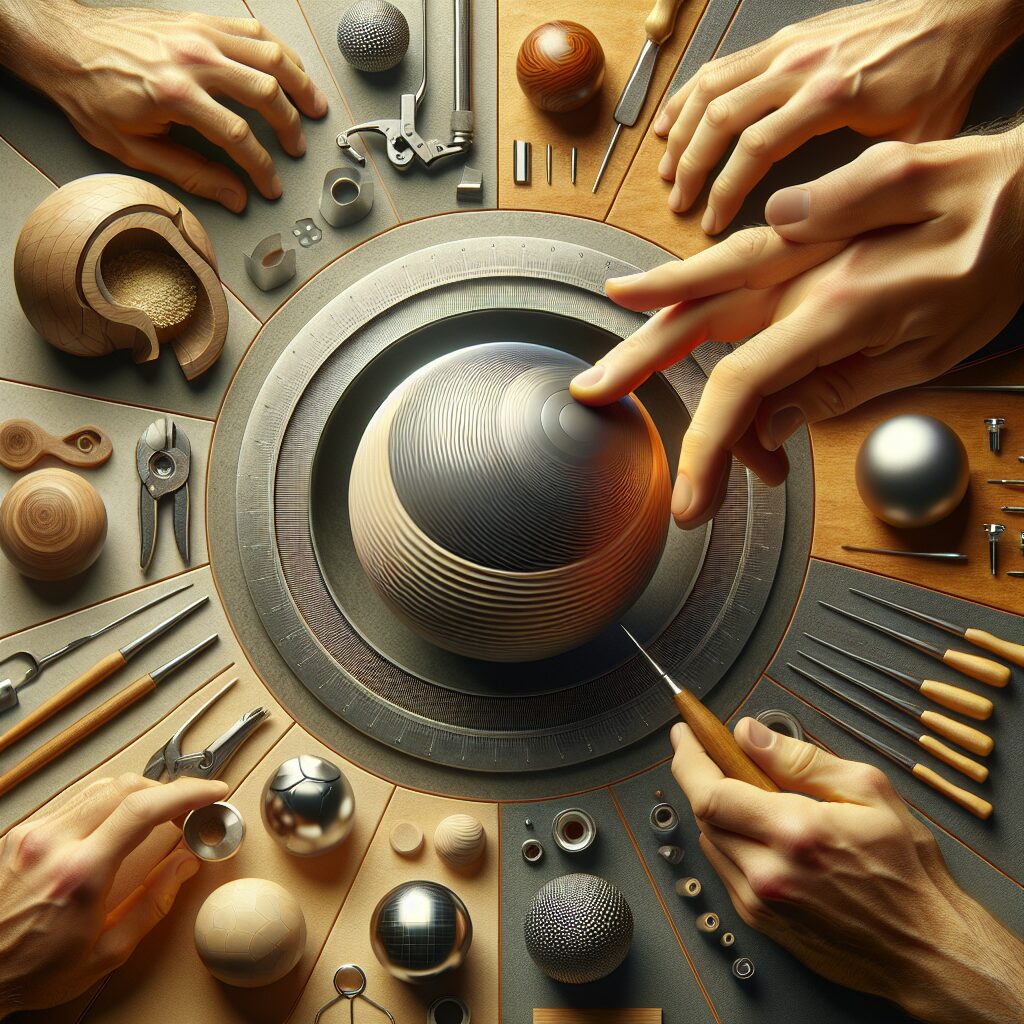Precision shaping is a delicate art that plays a fundamental role in the fabrication of ball bearings. But what exactly is precision shaping? In simple terms, it refers to the meticulous process of shaping balls with utmost accuracy and precision to meet the strict industry standards. This technique is crucial because any slight variation in shape or size can affect the performance and reliability of ball bearings, which are widely used in countless machines and equipment across various industries. This article dives into the world of precision shaping, exploring its unique features and the specific impacts it has on the quality and functionality of ball bearings.
When it comes to precision shaping, one of the key takeaways is the undeniable craftsmanship involved in the process. Highly skilled technicians and engineers meticulously shape the balls, ensuring that each one conforms to the exact specifications required. The precision and accuracy achieved during shaping directly translate into enhanced performance and durability of the ball bearings. Furthermore, precision shaping allows for greater load-bearing capacity and reduced friction, leading to smoother operation and improved efficiency of machines.
In the next part of this article, we will explore the various techniques and technologies employed in precision shaping, shedding light on how these advancements have revolutionized the ball fabrication industry. Stay tuned to uncover the fascinating world behind the craftsmanship of precision shaping and how it continues to shape our modern machinery landscape.
Key Takeaways
1. Precision shaping is a critical aspect of ball fabrication, ensuring the desired performance and quality of the product.
2. Craftsmanship and expertise play a vital role in precision shaping, as skilled technicians use specialized tools and techniques to shape balls accurately.
3. Precision shaping involves removing excess material from the ball’s surface through processes like turning, milling, and grinding, resulting in enhanced roundness and surface finish.
4. The dimensions of the ball, including diameter, sphericity, and surface roughness, directly affect its performance in various applications such as bearings, valves, and automotive components.
5. The quality of precision shaping greatly impacts the durability, efficiency, and reliability of the ball, making it crucial for manufacturers to invest in skilled craftsmanship and advanced shaping technologies.
What is the Importance of Precision Shaping in Ball Fabrication?
In the world of ball fabrication, precision shaping plays a crucial role in ensuring high-quality and accurate results. From sports equipment to industrial machinery, precision-shaped balls are used in various applications where reliability and performance are paramount. This article dives deep into the craftsmanship involved in ball fabrication, exploring every aspect of precision shaping and its significance.
Understanding Precision Shaping Techniques
Precision shaping techniques involve the meticulous shaping and refining of balls to achieve the desired specifications. Craftsmen use advanced machinery and tools to carefully mold, cut, and polish the balls to precise tolerances. The goal is to create balls that are perfectly spherical, have smooth surfaces, and meet exact dimensional requirements. Let’s explore some of the primary techniques used in precision shaping:
1. Casting
Casting is a common method used in ball fabrication, especially for larger-sized balls. It involves pouring molten material, such as metal or plastic, into a shaped mold. This molten material then solidifies to form the desired ball shape. The casting technique allows for the production of complex shapes and a range of materials with different properties.
2. Machining
Machining is a precision shaping technique that involves removing material from a solid piece to achieve the desired ball shape. Craftsmen use specialized machines, such as lathes and mills, to carefully sculpt the material into the required dimensions. Machining offers high accuracy and excellent surface finishes, making it ideal for producing balls with tight tolerances.
3. Grinding and Polishing
Grinding and polishing are essential steps in precision shaping to ensure the balls’ surface quality and dimensional accuracy. Grinding involves using abrasive wheels to remove excess material and refine the ball’s shape, while polishing further enhances its surface smoothness. These processes require skilled craftsmen who understand the optimal grinding and polishing techniques for each ball material.
The Significance of Precision Shaping
Precision shaping in ball fabrication is of paramount importance due to several key reasons:
1. Performance and Accuracy
Precision-shaped balls guarantee optimal performance and accuracy in their intended applications. Whether it is a ball used in a ball bearing or a sports ball, such as a golf ball or tennis ball, the shape and dimension directly impact the ball’s behavior, trajectory, and overall performance. With precision shaping, manufacturers can achieve consistent results and ensure reliable performance.
2. Durability and Longevity
A well-shaped ball is structurally sound and less prone to wear and tear. Balls that undergo precision shaping are more durable and have increased longevity compared to those with irregular shapes or surface imperfections. This is particularly critical in industrial applications where balls are subjected to high loads, impacts, and repetitive movements.
3. Reduces Friction and Improves Efficiency
Precision shaping results in smoother ball surfaces, reducing friction and improving efficiency in various applications. In industries such as automotive and aerospace, precisely shaped balls used in bearings or valves help minimize energy loss due to friction, ultimately enhancing overall system efficiency.
4. Enhances Product Quality
For manufacturers, precision shaping is crucial for maintaining product quality standards. Irregularly shaped or poorly dimensioned balls may lead to product defects, malfunctions, or even safety hazards. By investing in precision shaping, manufacturers can produce balls that meet tight tolerances, ensuring consistent quality across their product lines.
Guides for Achieving Precision Shaping in Ball Fabrication
Are you involved in ball fabrication and aiming for precise shaping? Here are some essential tips to guide you:
- Invest in high-quality machining tools and equipment for accurate shaping.
- Ensure proper material selection, as different materials require specific shaping techniques.
- Regularly calibrate and maintain your shaping machinery to ensure consistent results.
- Train and empower skilled craftsmen with expertise in precision shaping techniques.
- Implement strict quality control measures to detect any shape or dimensional deviations early.
- Collaborate with suppliers who specialize in precision ball fabrication to leverage their expertise.
- Stay updated with the latest advancements in precision shaping technologies for continuous improvement.
By following these guides, you can elevate your ball fabrication process and achieve superior precision shaping, leading to higher-quality balls and satisfied customers.
Frequently Asked Questions
What is Precision Shaping in Ball Fabrication?
Precision shaping in ball fabrication is the meticulous process of carefully crafting balls to achieve the desired specifications, dimensions, and properties. It involves the use of advanced manufacturing techniques to ensure utmost accuracy and precision.
Why is Precision Shaping important in Ball Fabrication?
Precision shaping plays a crucial role in ball fabrication as it directly impacts the performance and quality of the final product. By employing precision shaping techniques, manufacturers can achieve better spherical shape, improved surface finish, and enhanced mechanical properties, leading to superior performance in various applications.
What are the key benefits of Precision Shaping?
Precision shaping offers several benefits in ball fabrication, including:
- Improved roundness and spherical accuracy
- Enhanced surface finish
- Consistent dimensions and tolerance control
- Optimized mechanical properties
- Reduced material waste
What manufacturing techniques are used in Precision Shaping?
Manufacturers employ various techniques for precision shaping, such as grinding, lapping, honing, and polishing. These methods allow for the removal of material in a controlled manner to achieve the desired shape and surface quality.
What industries rely on Precision Shaped balls?
Precision-shaped balls find applications in a wide range of industries, including automotive, aerospace, medical, semiconductor, precision measurement, and many others. They are used in applications where accurate motion control, precise alignment, low friction, and reliable performance are critical.
How is the quality of Precision Shaped balls ensured?
To ensure the quality of precision-shaped balls, manufacturers implement rigorous quality control processes. This includes comprehensive inspection and measurement techniques, such as optical metrology, surface profilometry, and dimensional analysis. Additionally, advanced testing methods like hardness testing and ball roundness analysis are employed to guarantee the desired quality standards.
Can Precision Shaping be customized for specific requirements?
Absolutely! Precision shaping can be customized to cater to specific requirements and applications. Manufacturers collaborate closely with clients to understand their unique needs and develop tailored solutions that meet their precise specifications.
Is Precision Shaping cost-effective?
While precision shaping may involve advanced techniques and processes, it often proves to be cost-effective in the long run. The superior quality and performance of precision-shaped balls result in increased efficiency, reduced downtime, and extended lifespan, outweighing the initial investment.
How does Precision Shaping contribute to sustainability?
Precision shaping plays a role in sustainability by minimizing material waste through precise material removal and optimization. The accuracy achieved through precision shaping ensures that only the necessary materials are used, reducing overall environmental impact.
Can Precision Shaping be combined with other manufacturing processes?
Absolutely! Precision shaping can be combined with other manufacturing processes to further enhance the properties and functionalities of the final product. For example, precision-shaped balls can undergo additional heat treatment or coating processes to increase hardness, corrosion resistance, or lubricity.
Final Thoughts
Precision shaping is a truly remarkable craftsmanship that revolutionizes the field of ball fabrication. The meticulous attention to detail and utmost precision in shaping balls lead to exceptional performance and reliability in various industries. Whether it’s in aerospace applications demanding precise alignment or medical equipment requiring accurate motion control, the skillful art of precision shaping plays an indispensable role.
As technology evolves, the demand for precision-shaped balls will continue to rise. Manufacturers will constantly innovate and refine their precision shaping techniques to push the boundaries of what’s possible. The fusion of unparalleled craftsmanship and advanced manufacturing processes ensures that precision shaping remains a vital aspect of ball fabrication, contributing to the advancement of numerous industries and technological progress as a whole.




